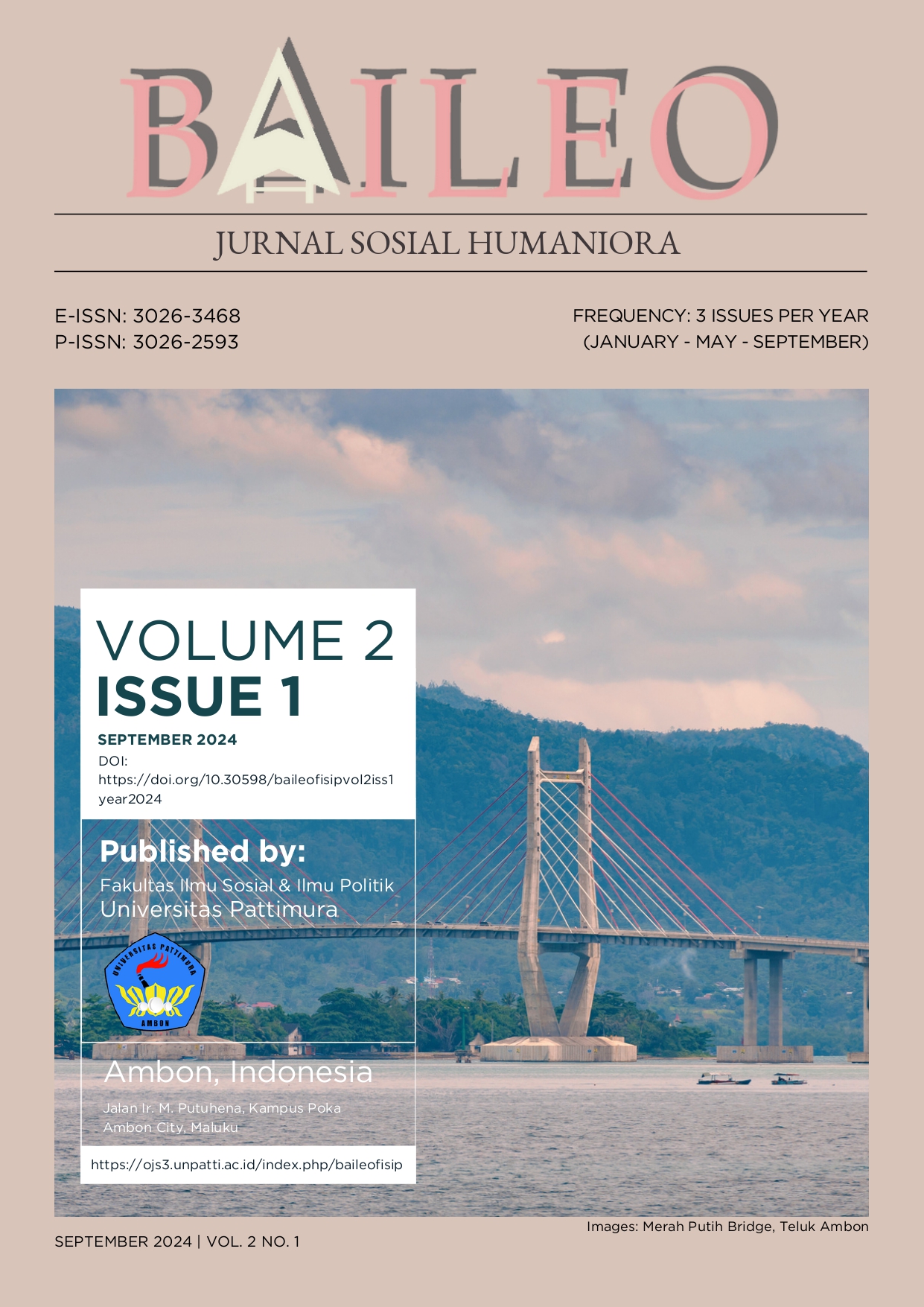Fighting Stereotypes: Expressions of Femininity in Public Spaces and the Challenge of Toxic Masculinity
Abstract
This study explores the dynamics of toxic masculinity and its impact on gender expression in public spaces in Negeri Rumahtiga, a community characterized by strong patriarchal structures. Employing a qualitative research design, data were collected through in-depth interviews, participant observations, and document analysis to uncover how hegemonic masculinity manifests and shapes individual behaviors. Findings indicate that toxic masculinity in public spaces harms not only women but also men who deviate from dominant masculine ideals, leading to psychological strain and social exclusion. Expressions of femininity in public are often met with ridicule or suppression, while men are pressured to conform to rigid expectations of strength, emotional restraint, and heterosexuality. This research highlights that masculinity is a socially constructed and contested identity, not an innate male trait. The study offers new insights by addressing the psychological consequences of toxic masculinity on men—an area often overlooked in previous literature. It recommends that sociocultural interventions and inclusive gender discourse are essential to challenging entrenched stereotypes and promoting gender justice. This contribution enhances the understanding of gender construction in localized contexts and supports broader efforts within social sciences and humanities to address structural inequalities and promote emancipatory social change.
Downloads
References
Afdhal, A. (2023). Peran Perempuan dalam Perekonomian Lokal Melalui Ekowisata di Maluku: Tinjauan Sosio-Ekologi dan Sosio-Ekonomi. RESIPROKAL: Jurnal Riset Sosiologi Progresif Aktual, 5(2), 208–224. https://doi.org/10.29303/resiprokal.v5i2.427
Ayuningrum, N. G. (2021). Analisis Wacana Kritis Komentar Seksual dalam Media Sosial Twitter Laki-Laki Berekspresi Gender Feminin. Jurnal Wanita Dan Keluarga, 2(2), 117–126. https://doi.org/10.22146/jwk.3620
Connell, R. W. (2005). Masculinities University of California Press. Berkeley, Los Angeles.
Connell, R. W. (2018). Masculinities and Globalization. Men and Masculinities, 1(1), 3–23. https://doi.org/10.1177/1097184X98001001001
Creswell, J. W., & Creswell, J. D. (2018). Research Design: Qualitative, Quantitative, and Mixed Methods Approaches (5 (ed.)). Sage Publications.
Hakim, M. A. (2018). Meruntuhkan Budaya Kuasa dan Kekerasan pada Anak: Belajar dari Ki Hadjar Dewantara. BUANA GENDER : Jurnal Studi Gender Dan Anak, 1(1), 79–90. https://doi.org/10.22515/bg.v1i1.64
Hermawan, I., & Hidayah, N. (2023). Toxic masculinity dan tantangan kaum lelaki dalam masyarakat Indonesia modern. Dimensia: Jurnal Kajian Sosiologi, 12(2), 171–182. https://doi.org/10.21831/dimensia.v12i2.60991
Ika, E. C. (2021). Konstruksi Makna Toxic Masculinity Pada Kalangan Mahasiswa Kota Bandung. Universitas Komputer Indonesia.
Irwan, Y. (2023). Gambaran Toxic Masculinity Pada Pria Dewasa Awal Dikota Makassar. UNIVERSITAS BOSOWA.
Jais, A. (2022). Toxic masculinity represented in Sol Yurick’s The Warriors. Universitas Islam Negeri Maulana Malik Ibrahim.
Jensen, A. L. (2024). Toxic Masculinity and the Public Square. University of Colorado at Boulder.
Johnson, R., & Ashworth, L. (2023). Gender Differences in Consumer Decision Making: A Meta-Analysis. Journal of Marketing Research, 60(2), 234–251.
Luthfiah, N. U. (2022). Representasi Maskulinitas Dalam Keluarga (Analisis Semiotika Roland Barthes Representasi Maskulinitas dalam Keluarga pada Film Pertaruhan). UPN’Veteran’Jawa Timur.
Merriam, S. B., & Tisdell, E. J. (2015). Qualitative research: A guide to design and implementation. John Wiley & Sons.
Mhembwe, S. (2019). Gender equality and women empowerment on sustainable community development in Zimbabwe. American Journal of Humanities and Social Sciences Research, 3(1), 66–75.
Nur, F. (2022). Konstruksi Sosial Maskulinitas Positif dan Kesehatan Mental (Studi Fenomenologi Toxic Masculinity pada Generasi Z). UIN Prof. KH Saifuddin Zuhri.
Piscopo, J. M., & Kenny, M. (2020). Rethinking the ambition gap: gender and candidate emergence in comparative perspective. European Journal of Politics and Gender, 3(1), 3–10. https://doi.org/10.1332/251510819X15755447629661
Ramdani, M. F. F., & Wisesa, P. A. D. (2022). Realitas Toxic Masculinity di Masyarakat. Prosiding Seminar Nasional Ilmu Ilmu Sosial (SNIIS), 1, 230–235.
Sarfo, J. O., Debrah, T., Gbordzoe, N. I., Afful, W. T., & Obeng, P. (2021). Qualitative Research Designs, Sample Size and Saturation: Is Enough Always Enough? Journal of Advocacy, Research and Education, 8(3), 60–65. https://doi.org/10.13187/jare.2021.3.60
Selvia, C. C., & Jatiningsih, O. (2023). Ketidakhadiran Pemimpin Perempuan di Forum Komunikasi Mahasiswa Bojonegoro Universitas Negeri Surabaya dalam Persepsi Pengurus dan Anggota. Kajian Moral Dan Kewarganegaraan, 11(2), 601–617.
Stromquist, N. P. (2018). Women’s E mpowerment and E ducation: linking knowledge to transformative action. European Journal of Education, 50(3), 307–324. https://doi.org/10.1111/ejed.12137
Waling, A. (2019). Problematising ‘Toxic’ and ‘Healthy’ Masculinity for Addressing Gender Inequalities. Australian Feminist Studies, 34(101), 362–375. https://doi.org/10.1080/08164649.2019.1679021
Wikström, M. C. (2019). Gendered bodies and power dynamics: The relation between toxic masculinity and sexual harassment. Granite Journal, 3(2), 28–33.
Copyright (c) 2024 Okto David Kristian Zega, Paulus Koritelu, Prapti Murwani

This work is licensed under a Creative Commons Attribution 4.0 International License.




